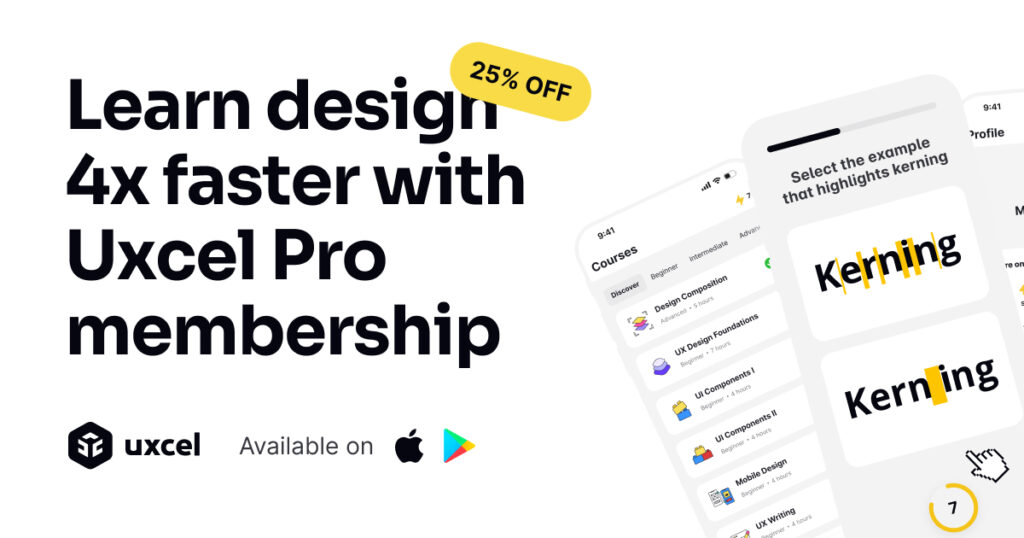UX design is bursting at the seams.
The field has exploded in recent years, with designers pouring in from all directions.
It’s crowded, competitive, and staying on the radar feels like a never-ending uphill climb. 🌄
Companies expect more.
They’re not just looking for someone who can whip up pretty interfaces.
They’re hunting for designers who can decode user behaviour, solve complex problems, and align with business goals.
Meanwhile, the industry is evolving fast.
AI, AR, and wearables are redefining what user experience even means.
Job titles are growing more niche, and employers are laser-focused on finding designers who bring something extra to the table.
So how do you stand out in 2025? 🌟
How do you become the designer companies can’t stop thinking about—and can’t wait to hire?
Here’s how you can make a lasting impression:
—
1. Nail the Basics (Yes, Again)
It’s tempting to chase trends and jump on every new tool that comes out.
But without solid fundamentals, you’re just another designer with a flashy toolkit.
Make sure you stand out for all the right reasons.
Even if you’ve been in UX for a while, it’s always good to revisit the core principles.
Sometimes, it’s easy to lose sight of them when you’re deep in your own processes.
Think about:
➡️ Usability: Are your designs intuitive and simple to use? Don’t just make things look pretty—make sure they work smoothly and efficiently for the user.
➡️ Accessibility: Are you designing for everyone, not just the average user? Think about how people with different abilities will interact with it.
➡️ Communication: Can you explain why you made certain design decisions to both designers and non-designers? Learn how to break down your thinking.
These skills will always be in demand, no matter how tech evolves. Focus here, and you’ll already be ahead of the pack.

2. Develop a Niche
Being a generalist is great, but specialists tend to get remembered.
It’s totally up to you which path to take, and being a generalist is a solid choice, especially when you’re starting out—it’ll help you land a job faster.
But as you grow in your career, consider if it’s worth narrowing your focus and becoming an expert in one area, rather than staying decent at everything.
Find a focus that excites you:
➡️ Micro-interactions: People love small details that delight.
➡️ Designing for wearables: Smartwatches, fitness bands, AR glasses—this market is booming.
➡️ Sustainable design: Can you create ethical, eco-friendly designs that align with future values?
Position yourself as the go-to person in the space of your choosing. Build a portfolio that reflects your expertise and unique voice.
3. Show You Understand Business Goals
Great design is strategically aligned with the goals of the business.
As a designer, you need to ensure your decisions balance both sides: creating meaningful user experiences while also meeting the bottom line.
➡️ Tie design decisions to results: Use data to show how your design improves key metrics like conversions, user retention, or engagement.
➡️ Work with product managers and stakeholders: Get on the same page about goals, user pain points, and priorities before diving into the design.
➡️ Present data-backed solutions: Whenever possible, back up your design choices with research, user feedback, and analytics. Showing how your design is making a real impact adds value and strengthens your position.
When you show you understand the bigger picture, you move from designer to strategic partner.

4. Get Comfortable with AI
AI isn’t replacing us—don’t buy into that.
But AI tools are everywhere, and most designers are already using them.
If you’re not, you’re falling behind.
That doesn’t mean you should let AI do your entire job, but using it smartly—to ask questions, gain direction, or speed up workflows—is the way to go.
There are plenty of AI-powered design tools out there, but UX Pilot is the one I personally keep coming back to.
You’d be amazed how much it can do.
It massively simplifies the product design process, generates detailed wireframes or even helps brainstorm Hi-Fi designs.
Check it out if you’re interested in something that can speed up your workflow, so you can focus on more important stuff.
Here’s how AI tools can assist you:
➡️ Analyze data: Use AI to uncover user behaviour insights in minutes.
➡️ Automate repetitive tasks: Free up your time for creative problem-solving.
➡️ Enhance accessibility: Identify usability issues and suggest inclusive design improvements.
➡️ Generate content: Create placeholder text, images, or even marketing copy to bring ideas to life faster.
AI-literate designers are leading innovation. Don’t be left behind.
5. Build a Portfolio That Stands Out
Your portfolio is your personal billboard.
In 2025, it’s not just what you show but how you show it.
➡️ Make it interactive: Create clickable prototypes or dynamic case studies.
➡️ Tell a story: Show the journey, not just the destination.
Include case studies that highlight your problem-solving process, the challenges, and the impact your design had on the end users or business.
➡️ Keep it polished: Simple navigation, consistent visuals, and clear messaging matter.
Treat your portfolio like a UX project—impress from the first click. Bonus points for including metrics or real-world impact from your designs.
6. Build an Online Presence
If you’re not posting, you’re pretty much invisible.
Share your thoughts on UX, post your work, or comment on industry trends.
Let others see you.
You can:
➡️ Share lessons learned from your projects: Talk about the wins, the struggles, and what you’d do differently next time.
➡️ Engage in UX discussions: Comment on industry trends, share your perspective and ask questions.
➡️ Post about your design processes: Break down how you approach challenges and solve problems—it helps others see how you think as a designer.
➡️ Show your personality: Post your sketches, prototypes, or even memes—let people get a sense of who you are.
➡️ Celebrate others: Highlight inspiring designs or shout out peers who are doing cool work.
People hire designers they know, trust, and feel connected to—build that visibility.
The more you show up, the more opportunities will come your way.
7. Keep Learning
UX is a dynamic field.
New technologies, methodologies, and user expectations emerge constantly, and what worked yesterday may not work tomorrow.
Thus, learning is more about ensuring your designs continue to meet user needs, rather than being competitive.
Stagnation in this field is not an option.
Continuous learning is a lifelong commitment for us.
⭐ Fortunately, there are plenty of online course providers to help us stay sharp—and often, they open doors to new career opportunities.
Uxcel, for example, can be a game changer for your UI/UX growth.
It helps you stay on top of new skills while boosting your appeal on the job market.
And right now, they’re offering a special discount—you can get 25% off the Pro Yearly membership if you sign up through the link above. ⬆️

To level up as a designer you can invest time in:
➡️ Design psychology: Understand the “why” behind user behaviour.
➡️ Emerging tech: Experiment with AR, voice interfaces, or advanced prototyping tools.
➡️ Networking: Attend meetups, webinars, or online communities.
➡️ Cross-disciplinary skills: Learn adjacent skills like content strategy, data analysis, or basic coding. A well-rounded skill set increases your ability to contribute in diverse ways.
The more adaptable and curious you are, the more valuable you’ll become. Make learning a habit, not a one-time task.
8. Emphasise Soft Skills
Whichever way you look at it, design is about people.
It’s not about arranging pixels on a screen—that’s a common misconception.
We design solutions for people and collaborate with others to make sure that our efforts hit the mark.
As much as technical skills matter, it’s your ability to connect, communicate and understand others that elevates your impact.
Try to work on your:
➡️ Empathy: Navigating the people-centred world of design takes a good dose of empathy.
And honestly, it won’t just make your designs better, it’ll help you build stronger relationships—in design and in every other area of your life.
➡️ Storytelling: Make your process captivating and relatable to others.
Want to see how storytelling can level up your designs? Check out my article here.
➡️ Flexibility: Feedback isn’t your enemy. As a designer, you’ve got to get comfortable asking for and receiving feedback, even when it’s not what you hoped for.
Trust me, most of the time, it won’t be what you want to hear—and that’s a good thing. It’s how we grow and improve. Always remember: we’re not the users.
Teams value someone who can navigate complexity, handle tough conversations, and build bridges between design and business.
You don’t need to know everything to stand out.
You rather, need to do a few things exceptionally well.
Be curious and authentic.
Find your unique voice and showcase the value you bring.
The UX landscape in 2025 is competitive, but it’s also full of opportunities for those willing to adapt, experiment, and invest in themselves.
Don’t shy away from finding a niche or showing off your soft skills.
And remember, your job is to solve real problems, not just push pixels around.
I believe that the most successful designers in 2025 won’t just be the ones with the flashiest portfolios or the trendiest skills.
They’ll be the ones who are empathetic, strategic, and unafraid to push boundaries.
Keep learning, stay curious, and be intentional about how you show up in the industry.
The UX world is big enough for you to carve your own path.
So, what’s your next move?
This space thrives because of YOU. ❤️
If the resources I share help you grow in your career, a small contribution from you could keep this community strong.
Together, we’re building a space to learn, grow, and support each other on this design journey.
Every bit helps, and by supporting me, you’re directly helping keep this space alive and growing.
Or simply scan this QR code ⬇️

Your support means a lot!
You might also like:
Share this article:




